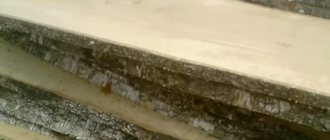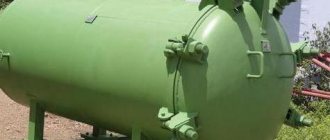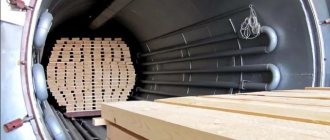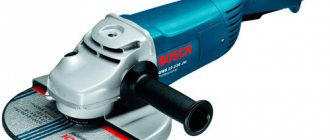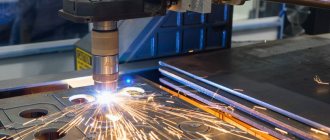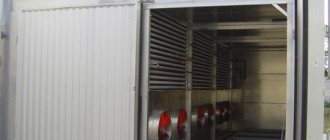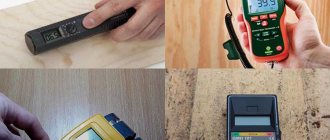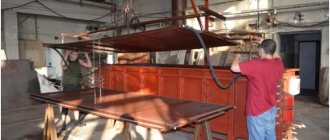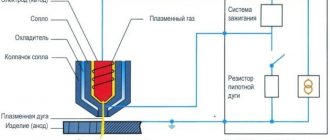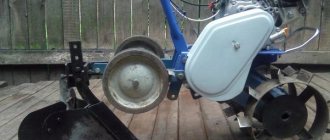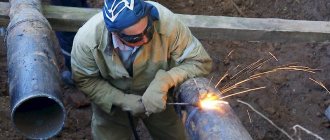Wood drying process
The primary task of a process such as drying wood is the process of evaporating excess moisture from the wood material. These processes occur in gradual stages:
- Initially, the surface of the wood dries;
- Further, moisture is released from inside the tree back to the surface;
- Then the drying of the surface layers of the wood is repeated.
Wood drying process
As a result of this process, a kind of equalization of the humidity regime of the wood and the surrounding air occurs. In principle, this process has been thoroughly studied over thousands of years of using wood in construction: although, today, more and more new technologies are appearing.
Helpful information. It is better to harvest wood material in the autumn and winter periods, when there are no sap flow processes in the trees.
Why dry wood?
As mentioned above, a felled tree contains a lot of water (from 30 to 50%), and any professional knows that the moisture content of the timber must be in balance with the humidity of the environment where the final product will be used. Otherwise, poorly dried material can significantly reduce the reliability of the building. Conversely, too much moisture loss leads to the wood shrinking, distortions and cracks appearing.
Damp wood has poorer strength of adhesive joints, has poor surface processing and lower some other mechanical and physical properties.
Drying technology
There are several types of drying technologies used in industry. All of them can differ in the types of equipment used, as well as in the various ways in which the heat itself is transferred to the material that is being dried.
Distribution of cold and warm air flows during drying
Basically, technological processes for drying different types of wood are divided into the following types:
- conductive drying method;
- Radiation technologies are also being used;
- The main technology for drying the material is the use of electricity
- technological process of convective drying of wood.
Convective drying of wood
Methods for measuring humidity
Moisture meter VPK-12M
Humidity is measured by direct and indirect methods.
The direct method involves taking and drying wood samples. The sample is placed in an oven, completely dried, and then weighed. The mass of the dried sample is then compared with the mass of the sample before drying. This method is quite accurate (error no more than 1%), but at the same time very long, which makes it difficult to use.
The indirect method uses electric moisture meters. They measure the electrical resistivity of the material being tested, which in turn depends and changes with humidity.
Indirect methods include:
- Conductometric method. A three-needle electrode is inserted from the end of the lumber and an electric current is applied. The moisture content of the wood is determined by the degree of its distribution.
- A sensor is used to measure the moisture content of wood chips. A small amount of chips is placed and pressed between the electrode disks of the collapsible cup.
- A four-needle probe is used to measure the moisture content of particle boards.
The indirect method of measuring humidity is fast and convenient, but at the same time has a large measurement error (1-10%)
Wood drying methods
Today, there are a great variety of different ways and methods of drying raw wood. But still, there are several basic and most commonly used methods for drying wood:
- The method of natural or atmospheric drying: is the cheapest, simplest in terms of the method of organizing the process, but at the same time the longest in time; In addition, this method requires large areas.
- Chamber drying of wood is not a very long process: drying lasts about a week, and defects such as cracking or uneven drying may occur.
- The infrared method is one of the highest quality: fast drying stages, ease of use, low electricity consumption, unsuitable method for closed types of premises.
- The vacuum drying method is the fastest, does not lead to various deformations, disadvantages: high price for equipment, high energy costs.
- Drying by condensation is fast - the output is high-quality material, it is most suitable for large-sized material.
Helpful information. In some cases, drying is carried out on concrete, which actively absorbs moisture. The tree is laid on a concrete base and gradually rotated.
Vacuum drying
Drying wood using the vacuum method involves the use of special vacuum drying chambers. This equipment consists of a special sealed chamber made of a material such as stainless steel. There is a rubber coating on the top of the camera, which is secured with a metal frame.
Wood is laid for drying in layers; between these layers special aluminum alloy plates are laid. In these aluminum plates themselves, hot liquid circulation processes take place: this liquid is supplied from an external boiler apparatus using a special pump device. A vacuum atmosphere is created using a vacuum pump.
Vacuum drying method in a special chamber
The wood is placed in this chamber, then the vacuum pressure level is set and the temperature regime is set. The drying process occurs in several stages:
- the wood is initially heated without turning on the vacuum pressure;
- then the drying process itself occurs directly in the presence of vacuum pressure;
- The last stage is the ventilation and cooling process of the wood: also under the influence of vacuum.
Drying wood in drying chambers
Using a variety of drying chambers allows you to quickly dry wood material. Drying processes can take about a week. It is possible to coat the wood with special anti-corrosion agents: this treatment greatly helps protect the wood from the effects of microbes and mold.
Loading wood into special chambers for drying
But there are also disadvantages to such methods of drying wood material. These include the possibility of the appearance of a wide variety of cracks and other types of wood deformation: as uneven drying processes occur. Processes that change the structural nature of wood occur, which is why a wide variety of manufacturing defects can appear in further processing processes of this material.
Deformation of wood - possible options during drying
But today, this method of drying wood is the most popular among manufacturers of wood materials: this is due to the ease of use, low cost equipment, and relatively short drying times.
Homemade wood drying - how to do it yourself
The initial stage of a process such as drying wood, in any case, must take place under the influence of atmospheric conditions, i.e. in street conditions. At this stage, the wood moisture level is reached: approximately twenty percent.
It is necessary to place the workpieces in a stack, which should be located on stands: air passages should be arranged inside the stack itself to facilitate uniform drying of the wood.
Wood stacked on stands
The final drying process should be carried out in a warm, fairly dry room. If there is excess humidity in the room, the reverse process of water absorption by the tree itself will occur. It is best to hang wooden blanks closer to the ceiling.
Sometimes the root drying method is used, when the tree below is extensively cleared of bark. Gradually the tree stops the process of sap movement, and in the future all that remains is to wait until it dries completely.
Digestion in boiling water can be used. Suitable for small workpieces. The wooden blanks are placed in a pan of water, boiled thoroughly for several hours, and then taken out to dry. A similar method is steaming in paraffin. Almost identical to boiling in water.
A smart owner can easily build a similar drying bin with his own hands
There is another method in which the tree is wrapped in several layers of dry newspaper, and then wrapped in plastic film, in which small holes are made. As moisture is absorbed, the layers of newspaper should be replaced several times.
Helpful information. If you use newspapers for drying, drying should occur in about three to four days: it is not recommended to speed up this process.
Advantages and disadvantages
Atmospheric drying has been used for many years. The peculiarity of the method is that it can be implemented at home without additional equipment. Main advantages:
- you don’t have to spend money on fuel and electricity;
- there is no need to build an additional drying room;
- the method does not involve the use of expensive equipment, which means that there is no need for skills to work with it;
- there is no need for additional personnel or labor costs.
The disadvantage of atmospheric drying is the duration of the process. It may take a year or even more to bring the tree to the desired condition. The exact time depends on the characteristics of the material, drying conditions, time of year and weather.
It is also important to strictly follow the technology
If you dry the wood incorrectly, it will warm up externally, but not internally. In this case, the risk of serious deformation is too great.
How to properly dry wood so that cracks do not appear in it?
Proper wood drying processes are the key to obtaining high-quality material, without the formation of various cracks and other deformations of the wood.
The arrows indicate the process of evaporation of excess moisture from wood
Drying wood under the influence of atmospheric air assumes the presence of exposure to weather conditions, therefore a change in appearance may occur under the influence of strong sun or rain.
Ventilated wood should be placed under awnings. The drying process should be organized immediately after sawing the wood. It is necessary to correctly position the stacks of wood, create a gap between the stack and the ground surface of at least five hundred millimeters, using a variety of pads for this.
Air channels should be installed between rows in stacks for a more uniform drying process. In order to prevent cracking processes, the ends of the wood should be treated with drying oil or any type of oil paint.
Automatic drying processes are simpler in this sense, since the necessary data is already built into the programs.
In automatic dryers, a necessary condition for avoiding the deformation process is strict adherence to wood drying technology.
Selection of wood texture pattern
Beginning woodworkers often do not pay attention to the texture pattern, mistakenly considering all boards to be the same. But in vain, because the appearance of the product largely depends on this. Material with an interesting pattern can be used to make panels or box lids, and straight-layer boards are perfect for frame parts and panel blanks. When assembling a shield, take a little time to ensure that the design on one piece matches the other. This way the product will look more attractive, and the joints will become less noticeable.
Wood drying equipment
Today, there are a great many manufacturers of equipment for drying wood, as well as many types of equipment itself. Let's look at the most commonly used of them.
Condensation drying chambers
Wood condensation drying chamber
Condensation drying chambers are a fairly new type of equipment. They have a low level of electricity consumption and are indispensable where there are no other types of energy besides electricity. But they have small loading volumes, which is why the drying process takes longer.
Vacuum dryers and their operating principles
Vacuum dryers are more expensive in terms of cost and energy use. The main advantage of this type of equipment is the rapid drying process of the wood. The control process is carried out through the operation of a microprocessor.
Vacuum dryer for wood - operating principle
Microwave dryers for wood
Microwave dryers are quite mobile, small in size, and have low electricity consumption. At the same time, they suffer from low loading volume. There is a possibility of uneven drying. In addition, processes of material combustion may occur.
When selecting equipment, you should consider the weather conditions of a particular region, take into account the area of the future business, prices for energy sources for a given area and focus on the types of materials produced.
What defects can form?
In the process of drying lumber, wood defects may appear in the workpieces, which are usually divided into hidden and obvious, that is, visible to the naked eye. If the natural tension of wood fibers exceeds permissible limits, then visible defects are formed, which usually include any cracks, fungal or mold damage, loss of knots, darkening of the wood color, as well as warping of the workpieces.
The appearance of hidden defects occurs after the formation of stresses in wood fibers, which is facilitated by the uneven distribution of moisture relative to the cross-section of the workpiece. In addition, uneven drying of the material is considered a hidden defect; this is most often observed when stacking workpieces during drying. The appearance of cracks, wrinkling, and warping in wood is usually caused by uneven drying. Defects of this kind can be seen on the end sections of workpieces; in addition, they can also appear in the form of internal or surface cracks located on the plane of the board.
The appearance of cracking in the end parts of workpieces is the most common type of defect, which manifests itself earlier than other types of drying defects. This is explained by the fact that the evaporation of moisture at the end parts of the board or beam occurs due to the high moisture conductivity of wood fibers located in the longitudinal direction. Loss of moisture causes shrinkage and tension in the fibers. The higher the degree of such stress, the greater the likelihood of the formation of cracks, which most often appear in the radial direction. A correctly selected drying mode, which will not cause the tensile strength of wood fibers to be exceeded, helps to avoid such a defect.
The formation of cracking in wood material occurs in stages. At the beginning of this process, shallow and small cracks appear, the direction of which is oriented deep into the thickness of the material by 4-5 mm. If at this stage the drying process is continued with the same parameters, then minor cracks will begin to expand, they can go even deeper into the wood structure and penetrate the entire cross-section of the workpiece.
As for such a defect as warping, on lumber it can be helical, as well as longitudinal and transverse. All types of warping can be present even on one workpiece, but only one of them will be clearly visible. Most often, lumber with a wide surface area of 20 cm or more is susceptible to transverse warping. This defect is especially often visible when sawing mixed or tangential types.
When sawing radially, the workpieces are subject to warping quite rarely. The quality of the wood also influences the twisting of lumber or its longitudinal warping. For example, such a defect most often occurs if the original workpiece has a heel or cross-layered wood fibers, but it is advisable to discard such workpieces even before the drying process begins. Warping is a consequence of a violation of the technology of the wood drying process. During storage, the formation of this defect can be caused by an insufficient number of spacers between the boards, as well as different heights of such spacers.
If you unload uncooled materials from the drying chamber immediately after the end of the drying cycle, there is a risk that the wooden blanks will be subject to warping after cooling. To avoid the appearance of such a defect, you will need to not only follow the technology of the material drying process, but also the rules for its storage. For this purpose, in a stack of lumber, the top 2-3 rows of blanks are secured in special pneumatic clamps, and sometimes a load pressing on them is evenly placed on top of the dried boards.
Why do you need to figure it out first?
In most cases, a small business or hobby that provides additional income related to wood processing requires such an operation as drying the wood. Previously, in order to enter this business, huge expenses were required for the construction and purchase of a dryer, and for processing equipment.
Therefore, before investing in any event, you need to calculate everything and draw specific conclusions for yourself. For example, if I were organizing my own small production with wood drying, I would make calculations and provide for the following things:
- How much will it cost me to dry one cubic meter of lumber, taking into account the costs of the process itself and personnel;
- What profit per month will I have from organizing such a complex;
- How much will it cost to organize your own complex?
- How long will it take to organize your complex?
- If I make some kind of product from a dry board, then what savings will I have from one cube of sawmill per month;
- At what price will I buy a wet board and at what price can I buy a dry one?
- How much more profitable is it for me to dry the lumber myself than to buy it;
- What will I do with the lumber that has become unusable during the drying process, cracked, and turned blue?
Today, I will express my opinion on organizing the process on a small scale.
